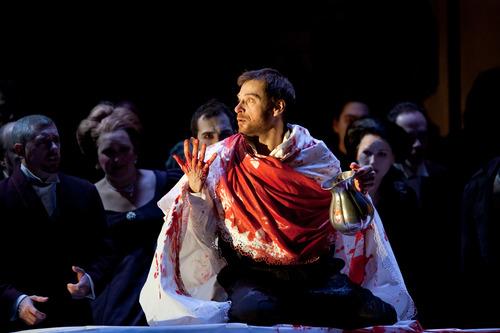
The new production of Ambroise Thomas’s 1868 Hamlet—the first time the Met has staged the work since 1897—brings to New York a revival first performed fourteen years ago in Geneva. It is an opera that has met with a fair amount of derision over the years, chiefly for its laughable original ending in which Hamlet finishes off Claudius and mounts triumphantly to the throne of Denmark. (The Met production substitutes a cobbled-together and not especially satisfying alternative in which, following an unexpected intrusion of the Ghost into the graveyard scene, the prince more appropriately dies. Perhaps, since no one would mistake Thomas’s Hamlet for Shakespeare’s anyway, it would make more sense to restore the original happy ending.)
Overall it is a production of intermittent pleasures, chiefly musical. On opening night a boorish claque resoundingly booed the conducting of Louis Langrée, who to my ears had (despite a few ragged horn passages at the outset) capably and often beautifully sustained the tone of the work, with its firmly anchored balance between resounding choruses, full-bodied and neatly delimited vocal trios, duets, and solos, and the delicate lyrical passages that serve as preludes and entr’actes. The continuity of the whole is finally more important than any particular highlight; Thomas’s music, if rarely inspired, extends with complete control the prescribed variants of a single vein. The only moment when I was genuinely startled was at hearing an unexpected modern sound in the fifth act music of the gravediggers, as if a bar or two of Kurt Weill had leaked into the 1860s.
Any sense of deep dramatic involvement was evoked more by the work of the orchestra and the singers than by the staging of Patrice Caurier and Moshe Leiser. The production design centered around some large moveable walls that bore a disturbing resemblance to the room partitions frequently deployed at convention hotels, and the use of theatrical space seemed quite limited, very much horizontal and elongated, with only limited employment of depth, the singers often reduced to figures cast against big dark empty backdrops. The more frenzied moments (Hamlet pouring blood-red wine over himself at the end of the play scene, or running madly against a wall) seemed inadequate attempts to wrench the opera into a style at odds with its music.
It is admittedly hard to imagine a body language consonant with the stately four-square architecture of Thomas’s music, a body language that would not seem impossibly stilted and grandiose, but here the direction at times had a desperate quality, as if things needed to be modernized or livened up so as to keep the opera running. In fact it moves along very well on its own sonic gears, even if its pace might strike some contemporary listeners as ponderous or needlessly protracted. I was myself very pleased to be borne along, however unsurprisingly, on its pleasant underpinnings.
Where the directors did bring things to life was in the more intimate confrontations of the piece, notably in the second-act trio of Claudius, Gertrude, and Hamlet. Here was an object lesson in how to transform Shakespearean tragedy into walloping domestic melodrama, with Jennifer Larmore the driving force in her intensified rendering of a fear-wracked Gertrude. In this scene, as again in Gertrude’s third-act duet with Hamlet, the opera is like a chamber play in the French nineteenth-century style; it was not surprising to learn that Alexandre Dumas had a hand in the adaptation on which the librettists based their work. Instead of opening out into immense metaphysical or political perspectives, Thomas’s Hamlet narrows at its best into vigorously sketched emotional face-offs. For a moment you could almost imagine you were watching an opera based on one of Claude Chabrol’s thrillers set among the modern French haute bourgeoisie (while remembering that Chabrol himself indulged in his own Hamlet variation, the long-lost 1962 Ophelia).
The production is very much built around Simon Keenlyside’s quite stirring performance, beautifully sung (his diction was so clear that the lyrics could be understood without difficulty) and acted with an emotional expressiveness that sometimes made the music seem more subtle and ambiguous than it actually is (even when his costumes seemed designed to cast him, a little distractingly, as a trenchcoated Bogart surrogate). Marlis Petersen (replacing, more or less at the last moment, Natalie Dessay, who had sung the role elsewhere with Keenlyside) did full justice to Ophelia, a role requiring a great deal of fine singing but not much dramatic effectiveness.
For me the evening belonged—along with Keenlyside and Petersen and Larmore—above all to the much-maligned Ambroise Thomas. His score, widely characterized as mediocre and overlong, is a piece of machinery, but it’s machinery cast in an idiom whose pleasures are solid and consistently diffused, a matter not of flashes of inspiration but of unwavering attention. It’s an idiom that might be called industrial lyricism, evoking a world of firmly, none too subtly defined intentions and equally firmly defined limits, in which emotions are permitted to pour without restraint through channels carefully and sturdily built for that purpose.
Advertisement
In that light Ophelia’s mad scene can properly be appreciated as the enactment of an operatic convention, an analogue rather than a description of madness, a licensed, carefully circumscribed transgression. Perhaps such a scene can only assume its full meaning when imagined taking place at the Paris Opera in 1868. A work like the Hamlet of Ambroise Thomas cannot really be updated. It speaks with utter confidence the language of its moment. As we listen to it we are inevitably listening backwards.


